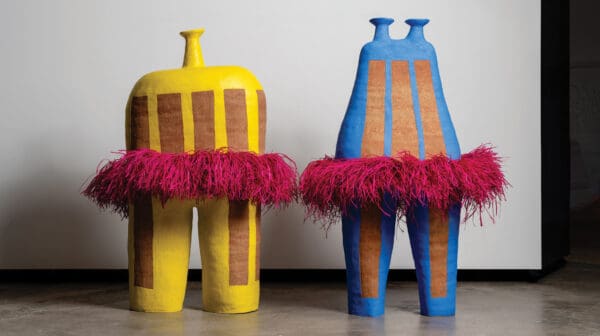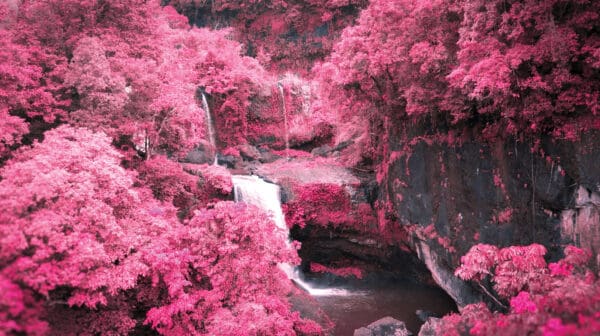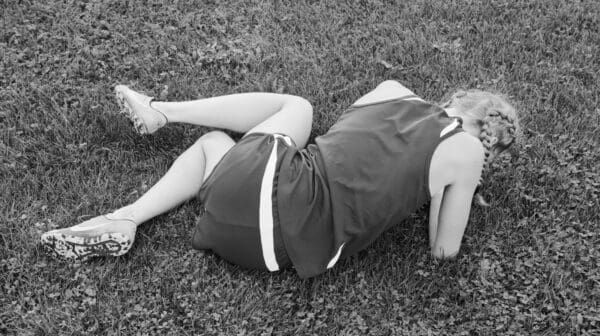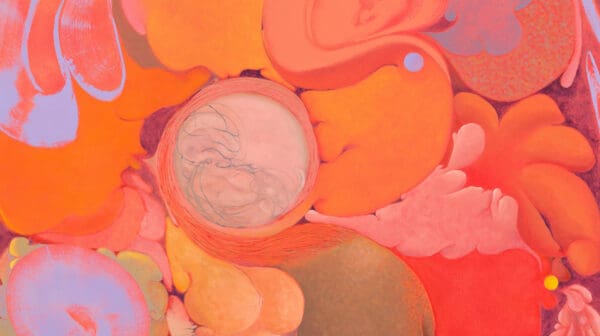From explorations of diaspora to Indigenous sovereignty, reality television to meditation, editor-in-chief Tiarney Miekus asked our writers to outline why these 10 artists are the ones to keep an eye on in 2024.
Georgia Banks
By Josephine Mead
Georgia Banks takes the contemporary construction of selfhood to the extreme.

Georgia Banks challenges the line between performance and reality. With conviction and satire she interrogates our social selves through reality television, beauty pageants and gamified apps. As her artist statement says, she’s “been banned from Tinder, sued by the estate of American artist Hannah Wilke, and named Miss Social Impact in a national beauty pageant.”
Take Bank’s Data Baes, 2023, an installation, AI bot and video which reflects the arduous process of applying for reality contests over nine months, ending in total rejection. Banks considers reality TV as a “contemporary Colosseum—a place for people to gather and watch human suffering, without social implication”.
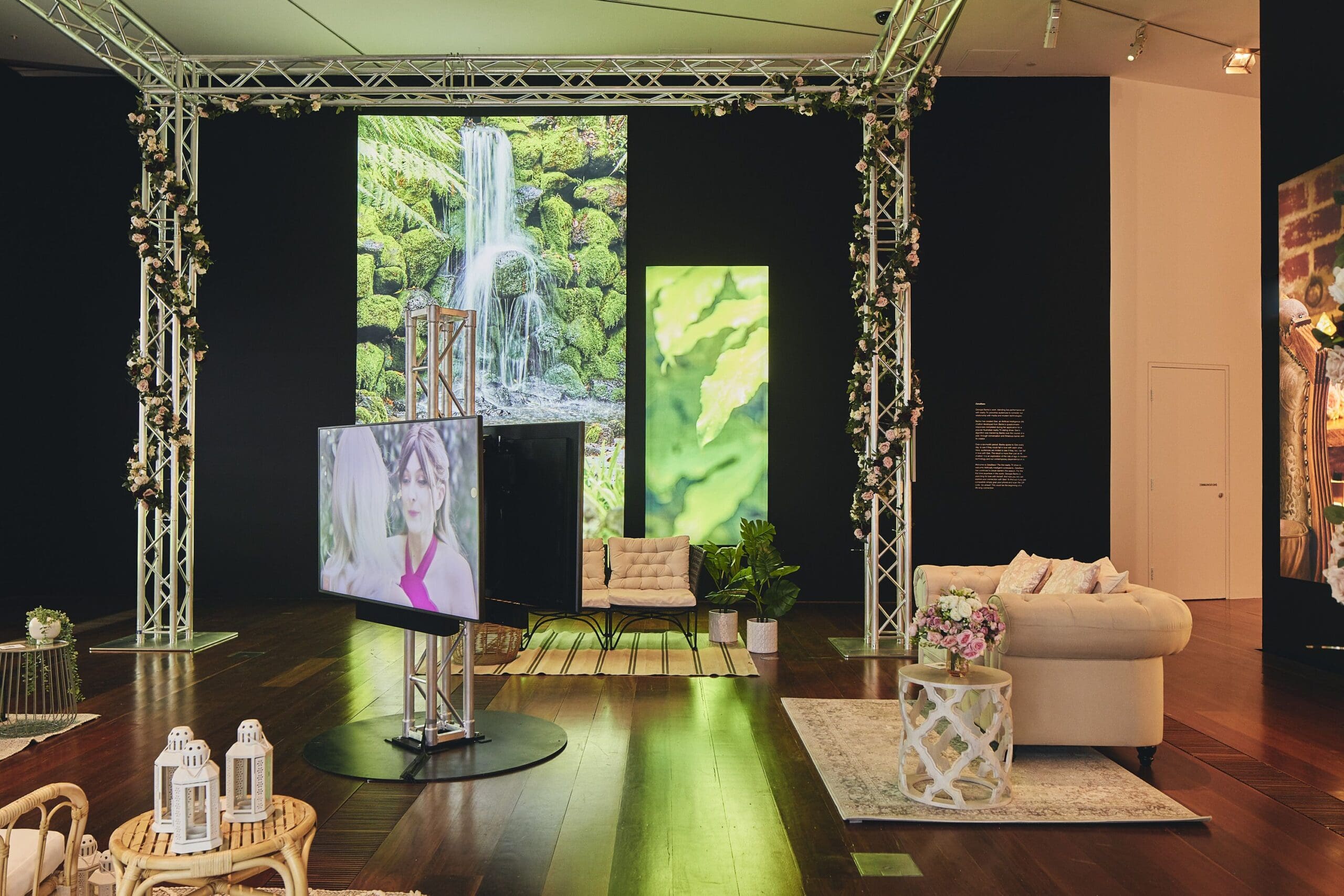
Is reality television the new still life painting? A portal to consider our demise? It’s watched with judgement preferred in Australia and without social accountability, where the impetus to participate belies a desire to be “known” after death. Banks taps into this, discovering meaning within the superficial, while securing her own ‘immortality’.
These post-mortem-esque vibes are further developed in her ongoing work, Remains to be Seen, where Banks runs a competition for someone to have “complete control over her death”, winning autonomy over all posthumous decisions. Similarly, her current Creative Australia-funded research explores the impacts of gamified apps (like Tinder and X) on self-creation and death. For 2024, she’ll exhibit for Cementa24 and will perform for Melbourne Art Fair.
Archie Moore
By Ellie Buttrose
Pushing political and formal boundaries, Kamilaroi and Bigambul artist Archie Moore is creating an ambitious installation for the 2024 Venice Biennale.

Archie Moore engages people on an emotional level through evocative familial stories and anecdotes of lived experience. The artist, who works from Redland Bay in South East Queensland, uses his personal history as an entry point to confront wider social issues and structural inequalities. In many of Moore’s exhibitions the viewer is immersed in his personal world—for instance, he has recreated his childhood home in the gallery. By placing audiences “in his shoes” Archie exposes gaps in understanding and social stratification.
On other occasions Moore has used ‘authoritative publications’ such as Australian parliamentary transcriptions, anthropological investigations, and coroners’ reports into Indigenous deaths in custody to visualise systemic injustices. He focuses on the racism that First Nations peoples have faced and continue to face in Australia: racial slurs directed towards him have appeared intext works and installations to show how these are not isolated or historical occurrences.
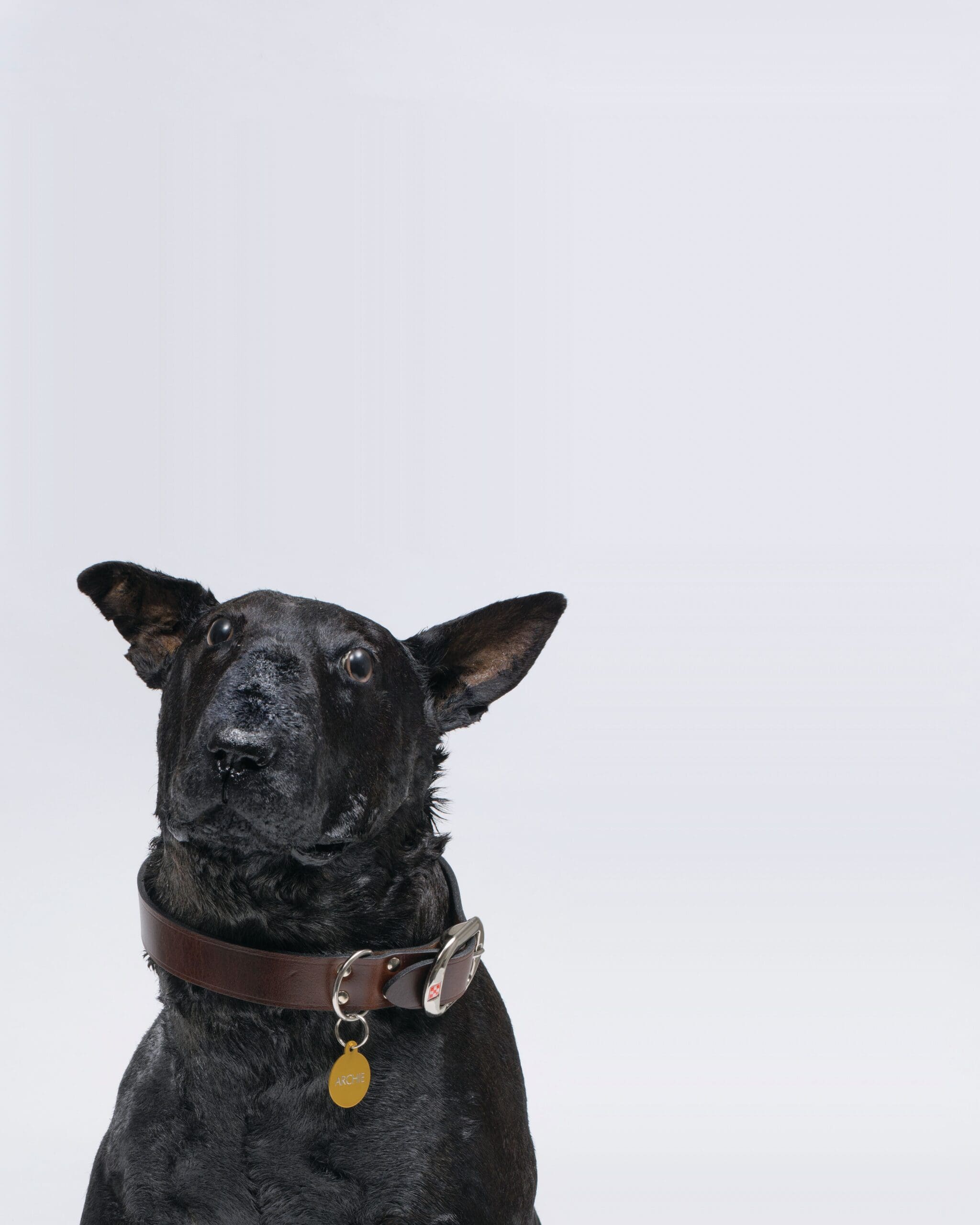
He’s also attentive to the pernicious policies that attempted to systematically erase Indigenous Australian languages—by incorporating Gamilaraay and Bigambul words into his artworks Moore contributes to broader language revival movements. What unites Moore’s conceptual artworks is how they deploy simple materials to convey the sovereignty of the self and sovereignty of one of the oldest continuous living cultures on Earth.
Archie Moore is represented by The Commercial and will present a new exhibition in the Australia Pavilion at the 2024 Venice Biennale (opening 20 April), curated by Ellie Buttrose.
Warraba Weatherall
By Andy Butler
Warraba Weatherall links art and academia with genuine action.
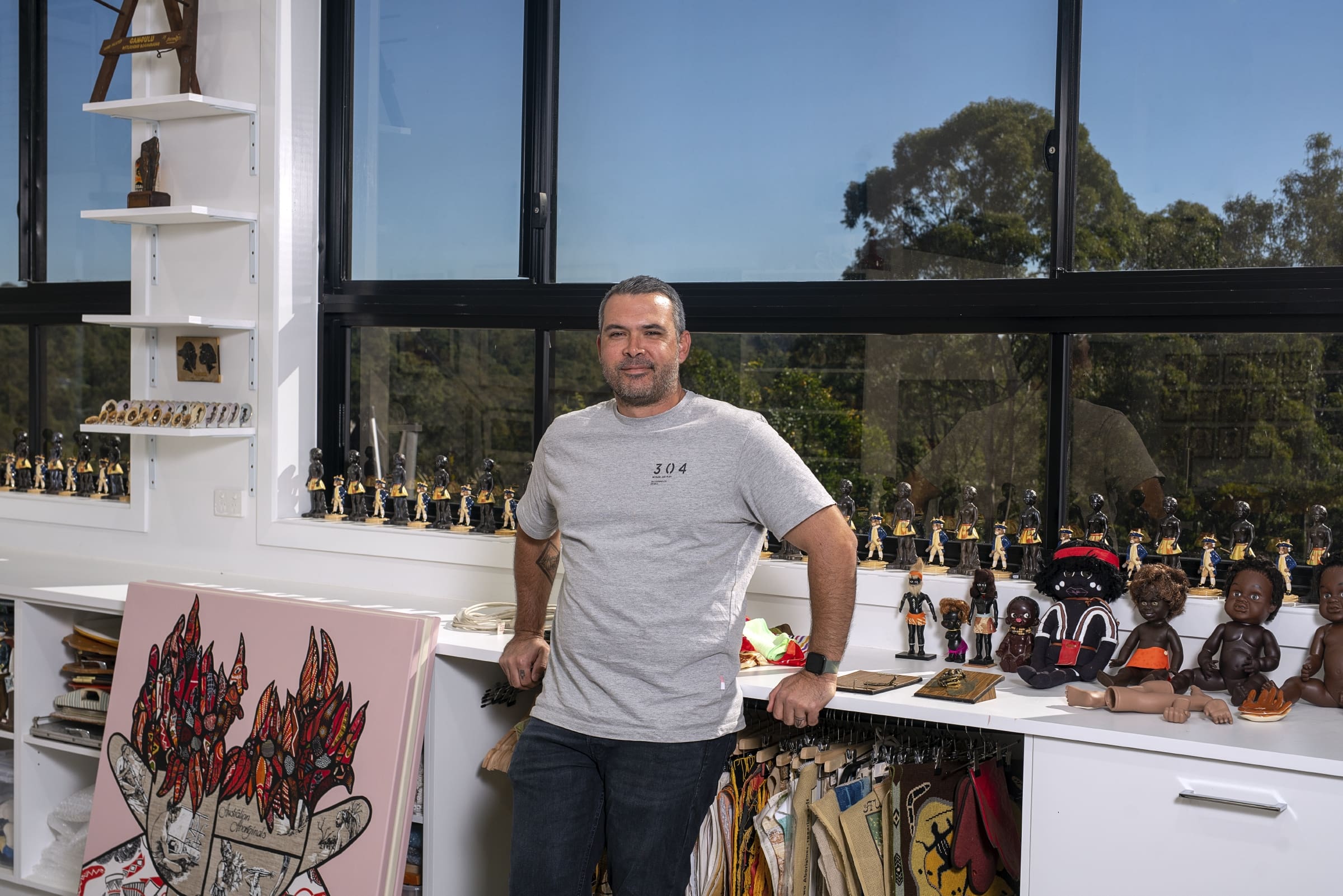
“I’m interested in tangible mobilisation rather than just sitting there and it being a talk fest. I want to be a part of things that genuinely bring change,” Warraba Weatherall tells me from Meanjin/Brisbane. He’s a Kamilaroi artist, curator and academic deeply embedded in the histories of Indigenous art and activism emanating from Queensland.
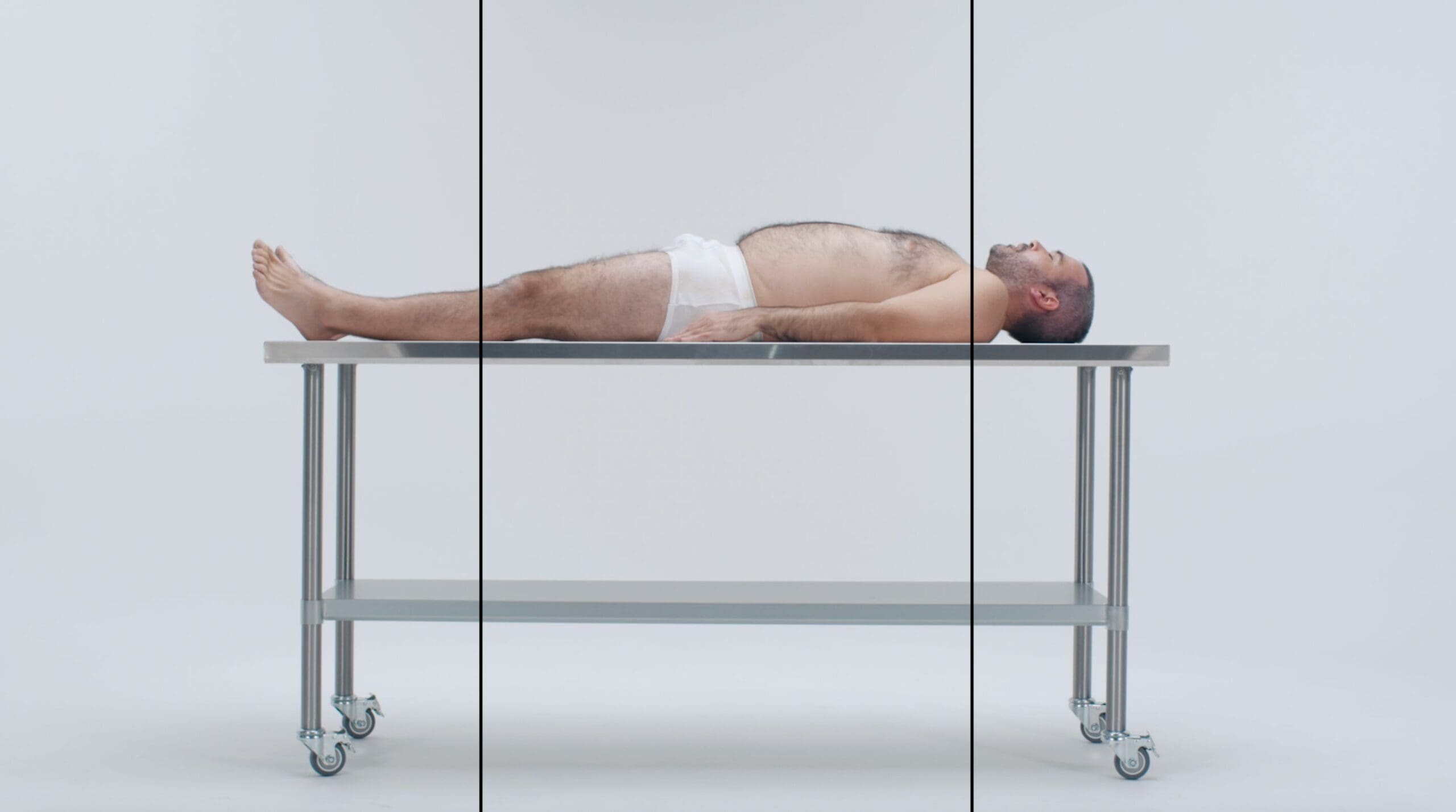
Queensland Art Gallery recently exhibited Weatherall’s To know and possess, memorial-like plaques referencing the Kamilaroi cultural property held in museums around the country. He’s growing a database of these objects to attempt to return ancestors and cultural property to the Kamilaroi people. This project is one of the ways he’s contributing to tangible change.
Weatherall is completing his PhD in the Contemporary Australian Indigenous Art (CAIA) program at Griffith University, as well as teaching the next generation of Indigenous artists, and has recently joined Brisbane-based collective ProppaNOW.
In 2024, he’ll exhibit a new major work at the National Gallery of Victoria for a series of First Nations commissions, with mentoring by Tony Albert. His relationships with an intergenerational community of Indigenous artists and activists is vital. “You get so used to working in silos as an artist, you need to have hard conversations and get feedback in a real safe space.”
Hannah Gartside
By Tiarney Miekus
Hannah Gartside is one of the most exciting artists working with textiles today.
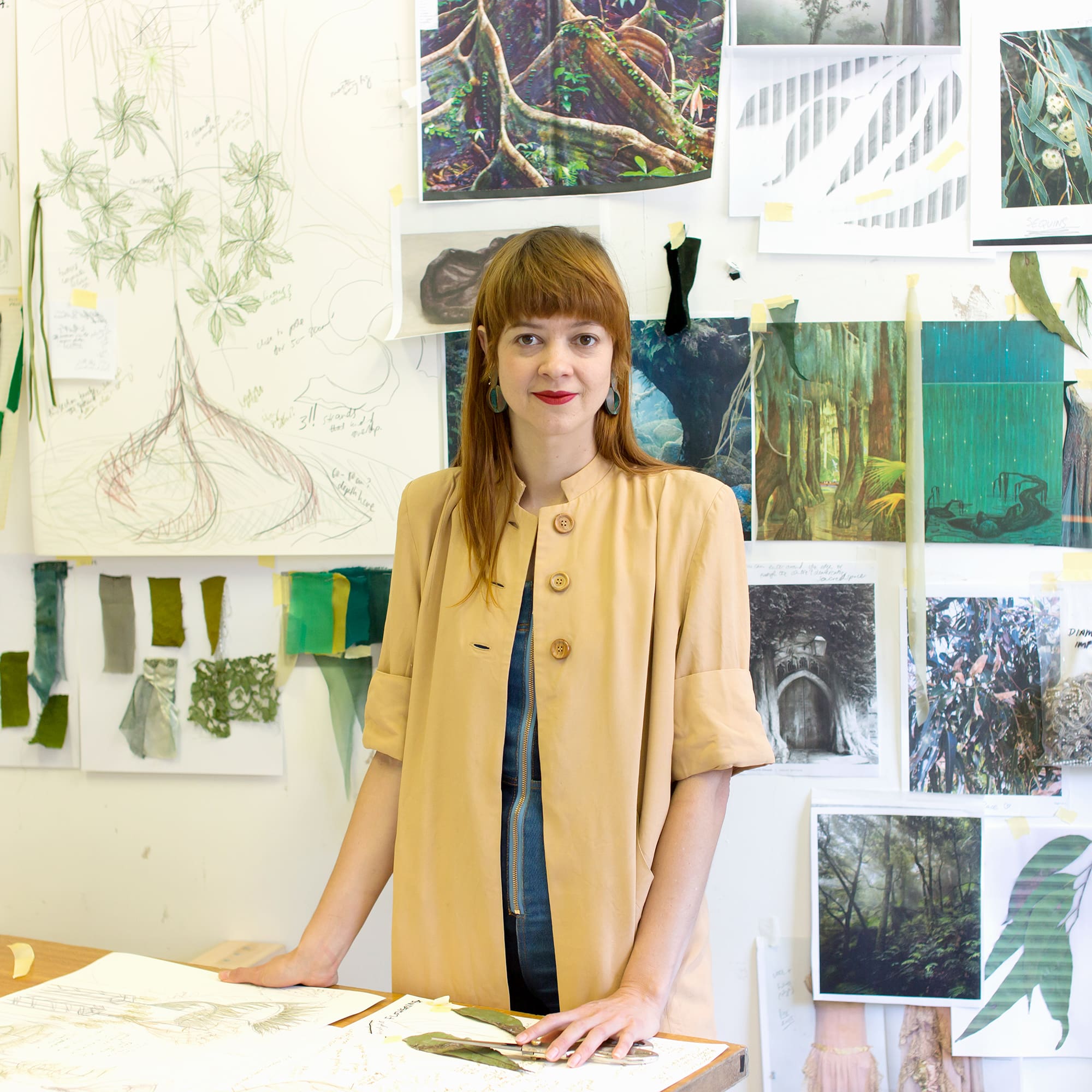
Hannah Gartside reveals the power, emotion and quiet politics of cloth. She’s known for her kinetic textile installations where found fabric twirls from floor to ceiling in hypnotic form, each piece gesturing to a significant historical woman.
These kinetic works have shown for Melbourne Now at NGV Australia and Primavera 2022 at the Museum of Contemporary of Art. For her recent debut at Tolarno Galleries, Gartside returned to stationary cloth, affixing formations of sequined material to the gallery walls, telling the story of a woman escaping mundanity and loneliness by creating a garment that transforms her into a moth. She joins a coven—and finds that all moths were once women.

In capturing metamorphosis Gartside shows a person finding freedom, which is exemplary of her wider practice: in releasing cloth from the limitations of class, status and appearance anxiety, Gartside finds pleasure and joy. But it’s not an easy or prescriptive pleasure; it’s a search for what pleasure truly is, and the bitter sweet hope of its attainability.
For early 2024 Gartside is in group exhibitions at Redcliffe Art Gallery and Tolarno Galleries, and will begin a project making quilts for families from the clothing of their deceased loved ones, as grief support. She’ll also head to the Netherlands for a mentorship with Claudy Jongstra’s studio.
Hannah Gartside is represented by Tolarno Galleries.
Eliza Gosse
By Sally Gearon
There’s a complicated nostalgia to Eliza Gosse’s architectural paintings of Australian environments—particularly our homes.
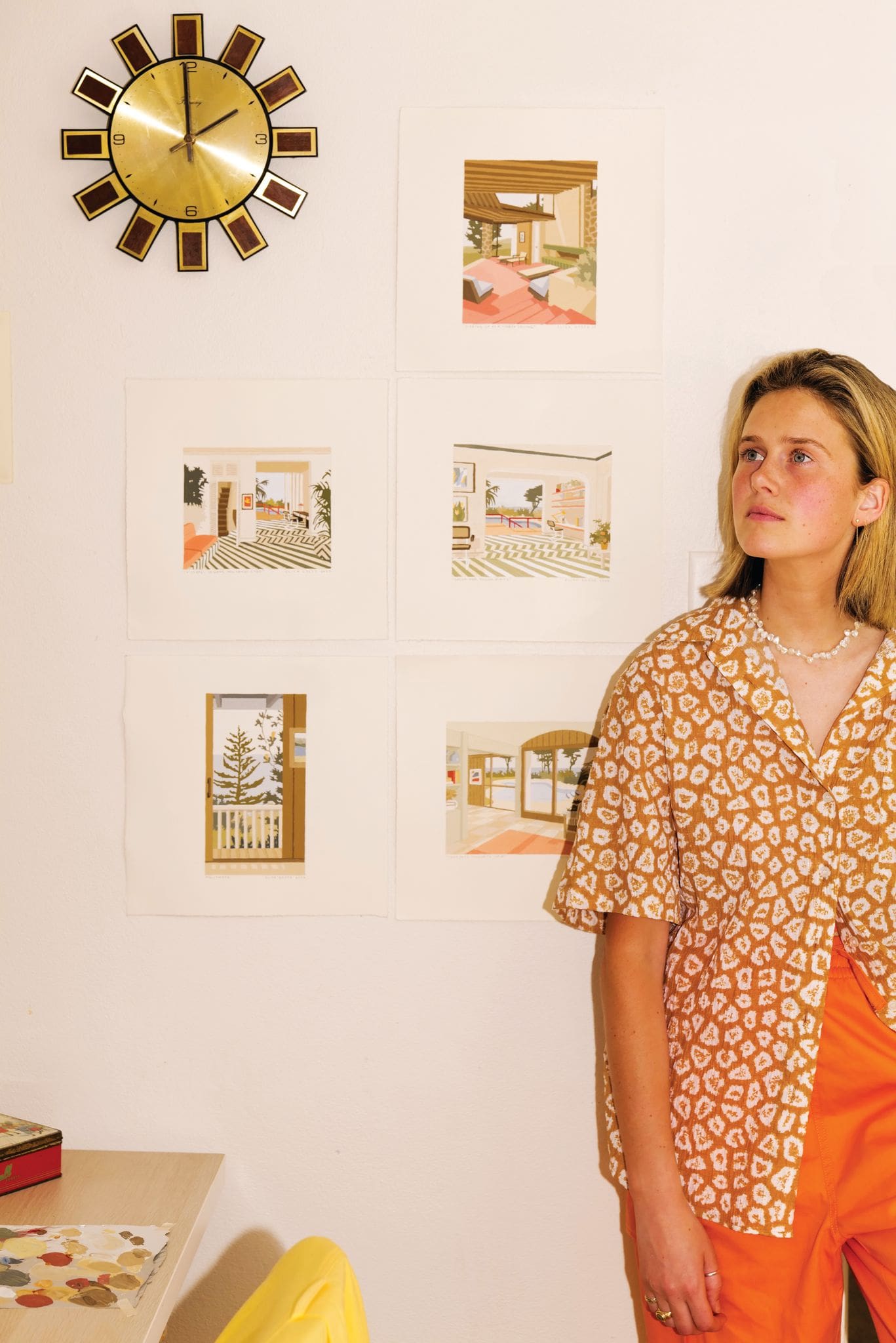
Eliza Gosse’s nostalgia-soaked paintings of mid-century modern architecture and interiors conjure simultaneous senses of past and present. Is this an inner-city retro-inspired dream house, or my nan’s suburban living room straight out of the 70s? Maybe it’s both. Maybe it’s Palm Springs. It’s reminiscent of how Howard Arkley saw beauty in suburbia, but instead of transposing this into vivid neons to counteract the banality, Gosse uses muted colour palettes and sleek finishings that honour design and the domestic.
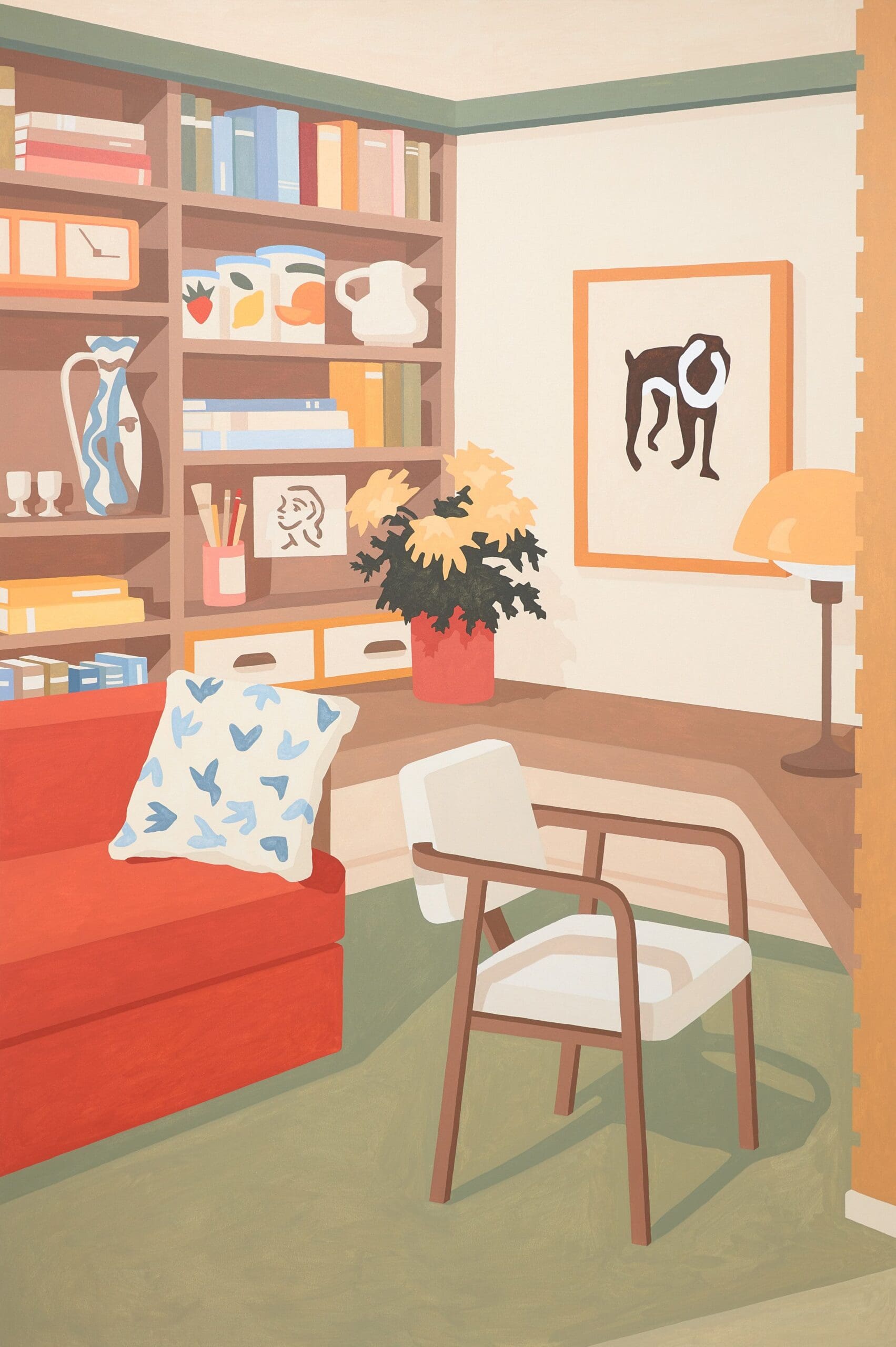
Gosse’s iconic houses have featured in exhibitions across both her representative galleries in the last year—Olsen Gallery in Sydney and Edwina Corlette in Brisbane, with titles like All My Friends Have White Walls And Beige Carpet and Entertainer’s Delight With Ocean Views. She also had an inclusion in MARS Gallery’s A Female Gaze in early-2023, and her works on paper featured in Galerie Camille Pouyfaucon in Paris. But it was her expansion into portraiture that caught the attention of many, as a finalist (for the second time) in the Archibald Prize for Breakfast at ours—in which life-size cut-out boards of herself and her husband, architect Benjamin Jay Shand, sit serenely, clad in matching bathrobes. This year, Gosse will exhibit at Olsen Gallery in May, alongside creating new work.
Eliza Gosse is represented by Olsen Gallery and Edwina Corlette.
Truc Truong
By Mariam Ella Arcilla
Between irreverence, meaning and humour, Truc Truong explores displacement and diaspora.
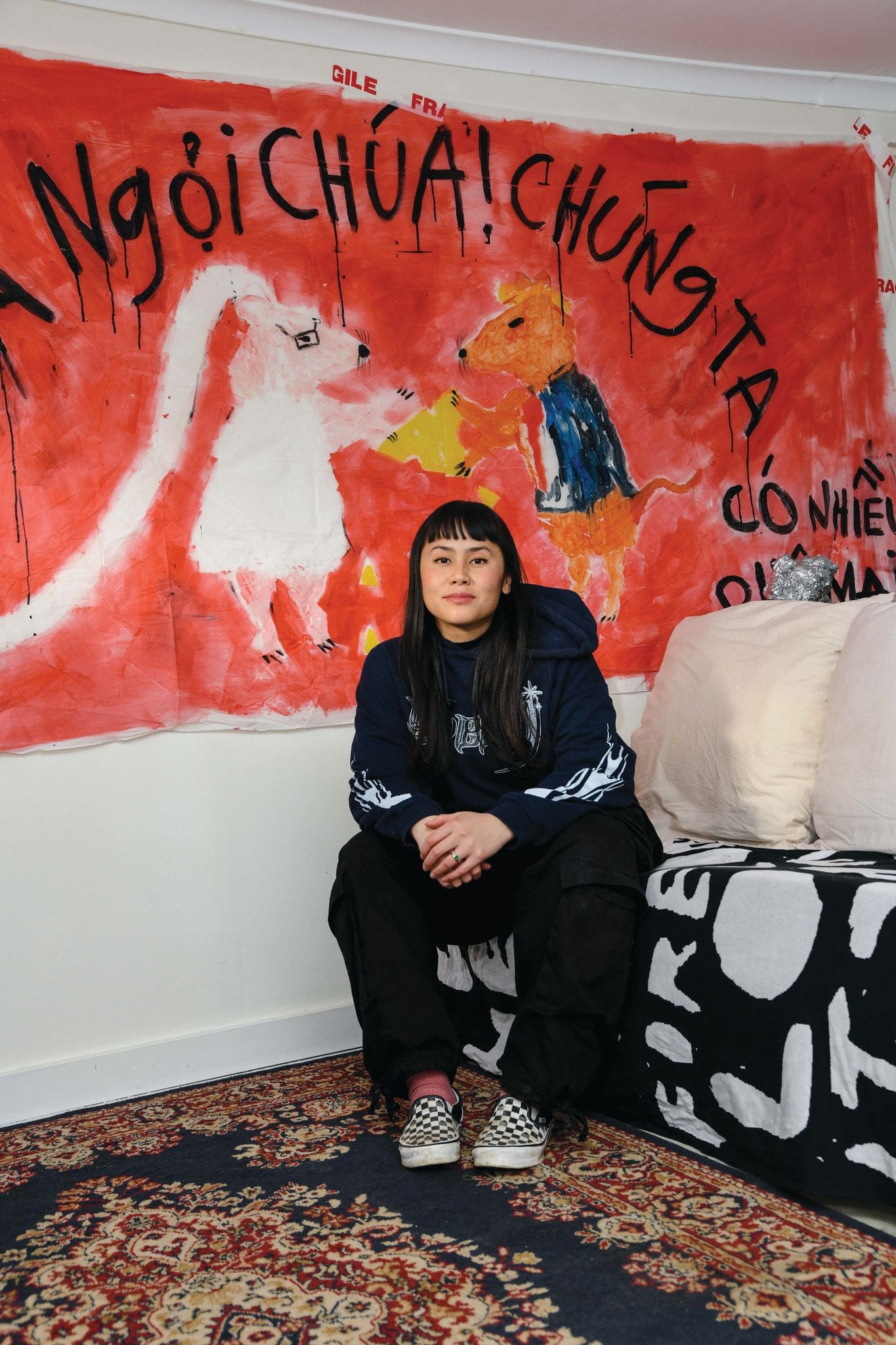
Misfits abound in the works of Vietnamese artist Truc Truong, who employs a spill-your-guts aesthetic to her sculptural installations and performances. Animal entrails, Sesame Street toys, and blow-up mascots are dismembered and skewered, cast alongside a littering of Asian snacks, pink housework gloves, and pop culture figurines that hark back to the artist’s childhood.
Born and based in Adelaide, Truong explores the internalised racism, cultural taboos and dualistic faiths experienced by her family since her parents migrated to Australia from Saigon in 1982. Prevalent in her work are hand-bleached textiles, Chinese-Vietnamese cuisine props, and pig intestines pristinely cleaned and cured by the artist to challenge the ‘model migrant’ narrative of obedience and studiousness. Truong recently wrapped up a year-long residency at ACE’s 2023 Studio Program, and is currently showing in Primavera 2023 at the Museum of Contemporary Art. Here, the artist manifests I Pray You Eat Cake, a kaleidoscopic anarchy of religious and cultural paraphernalia that depict a speculative conversation with her late grandfather, a practitioner of both Christian and Buddhist beliefs.
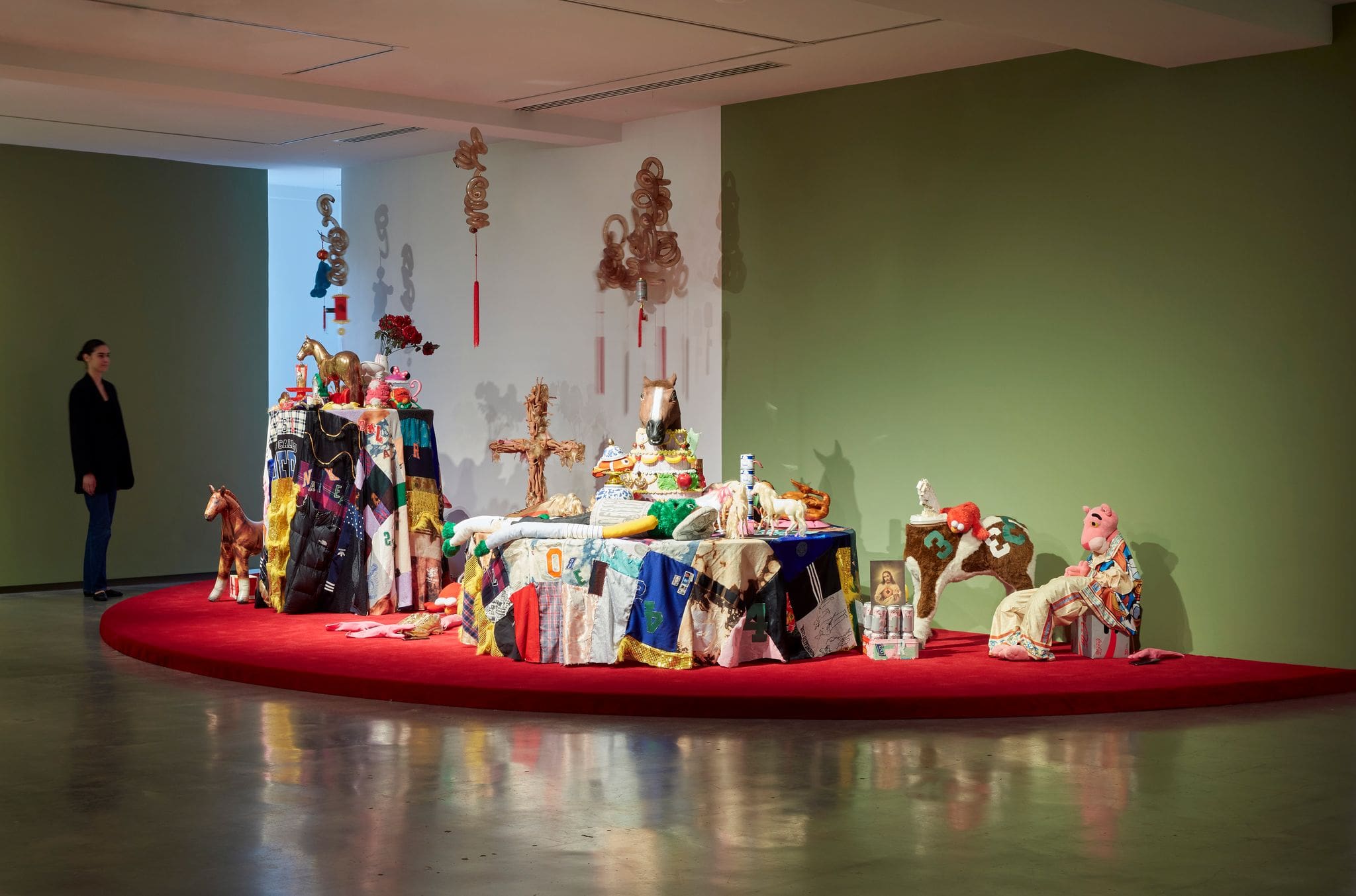
Truong roars into 2024 with a Saigon trip to learn from traditional Lion Dance craftspeople, and will feature in Gertrude Contemporary’s Octopus group show in July. She’ll further create an ambitious new work for Flinders University Museum of Art, as part of their Guildhouse Collections Project.
Corban Clause Williams
By Louise Martin-Chew
With a recent string of prize nominations and wins, Corban Clause Williams’s vivid paintings uniquely capture Country.
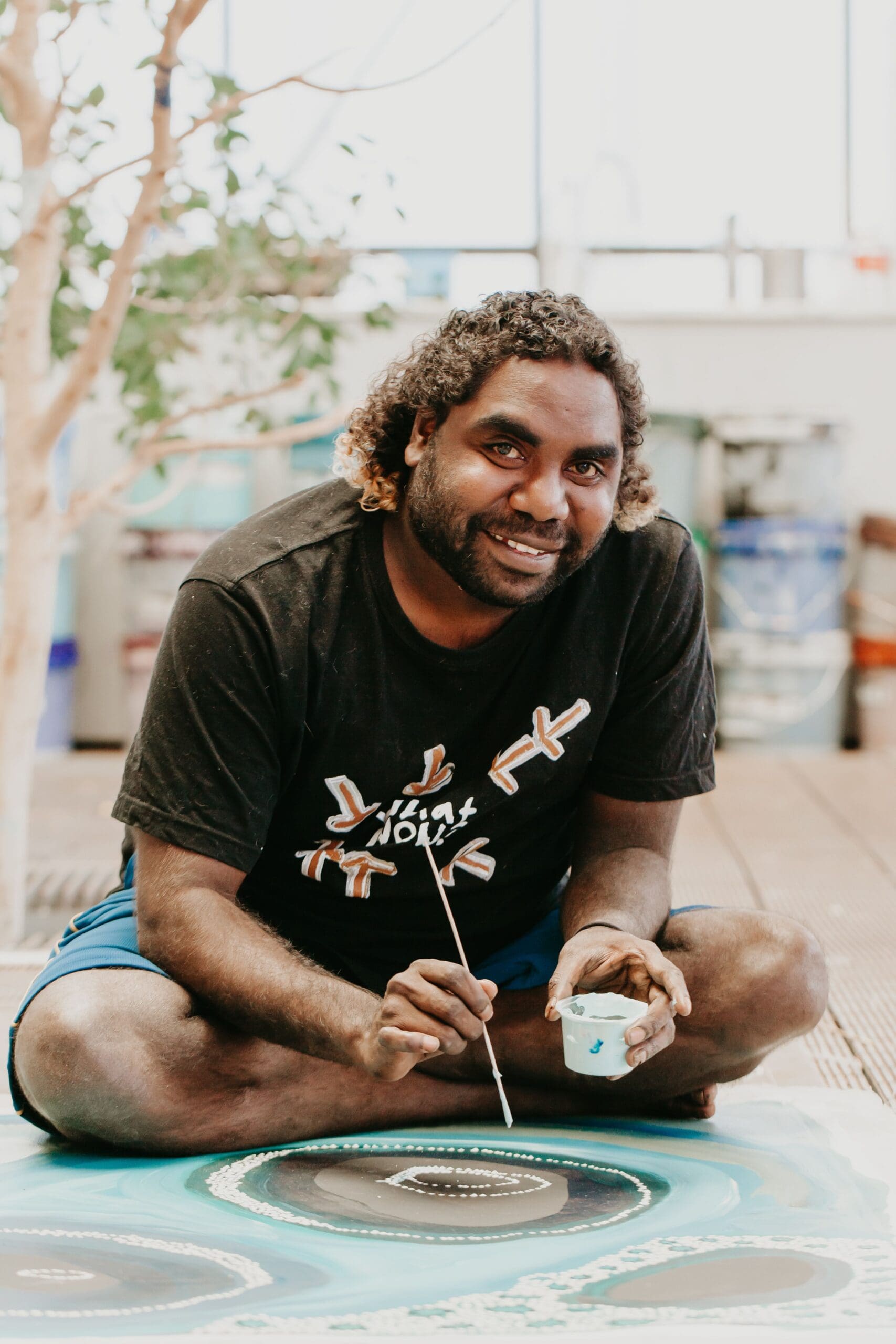
Corban Clause Williams’s success as the inaugural winner of the MA Art Prize (which recognises emerging talent) at this year’s Sydney Contemporary foreshadows his staggering potential. The win topped off a year in which Williams was also a finalist in the Ramsay Art Prize, the John Stringer Prize and the Telstra National Aboriginal and Torres Strait Islander Art Awards.
His painting for the MA Art Prize, Kaalpa (Well23, Canning Stock Route), was shown with Emilia Galatis Projects. He was applauded for his use ofcolour and the sensitive depiction of his grandfathers’s Country. The joy Williams feels on Country, which he captures, is palpable: “I went [to Kaalpa] for the first time [in 2018]…When I went there, I was pukurlpa (happy). It made you open up your spirit, it feels like home.”
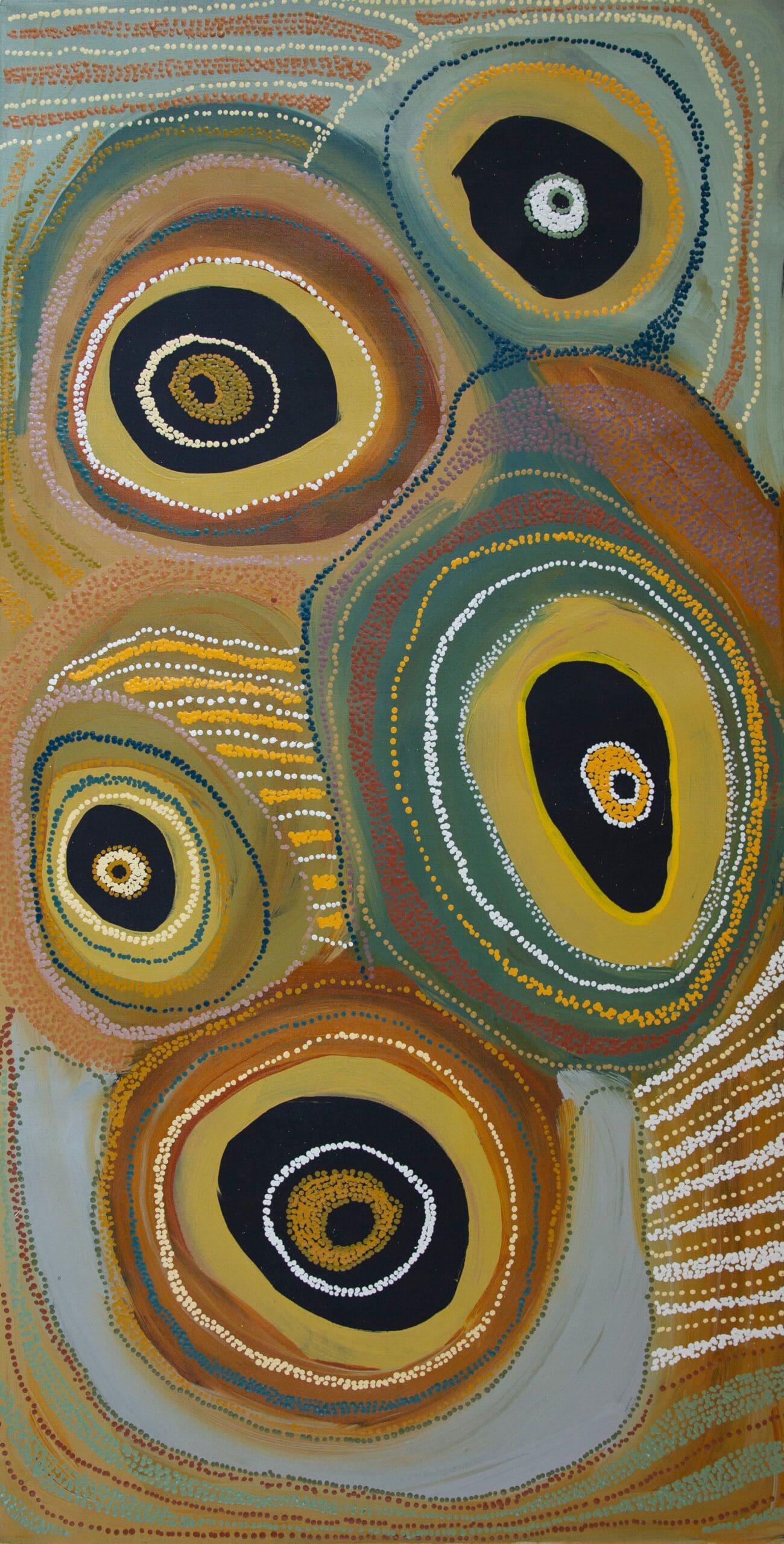
Williams, born in 1994, is a Manyjilyjarra painter from the Pilbara, who works with Martumili Artists and Galatis, who has known Williams since he was a teenager. “He’s worked at Martumili art centre for a long time,” Galatis explains, “and watched the senior artists, long before he began painting himself. I feel like what looks like an overnight success story was a decade of schooling.” Williams’s plans for 2024 aren’t fixed. “He’s not very fast and won’t be pushed, hence the quality of his work.”
Corban Clause Williams works from Martumili Artists and is represented by Emilia Galatis Projects.
Tiyan Baker
By Nanette Orly
A Malaysian Bidayǔh-Anglo Australian artist, Tiyan Baker works between history, language and digital processes, overturning Western conventions.
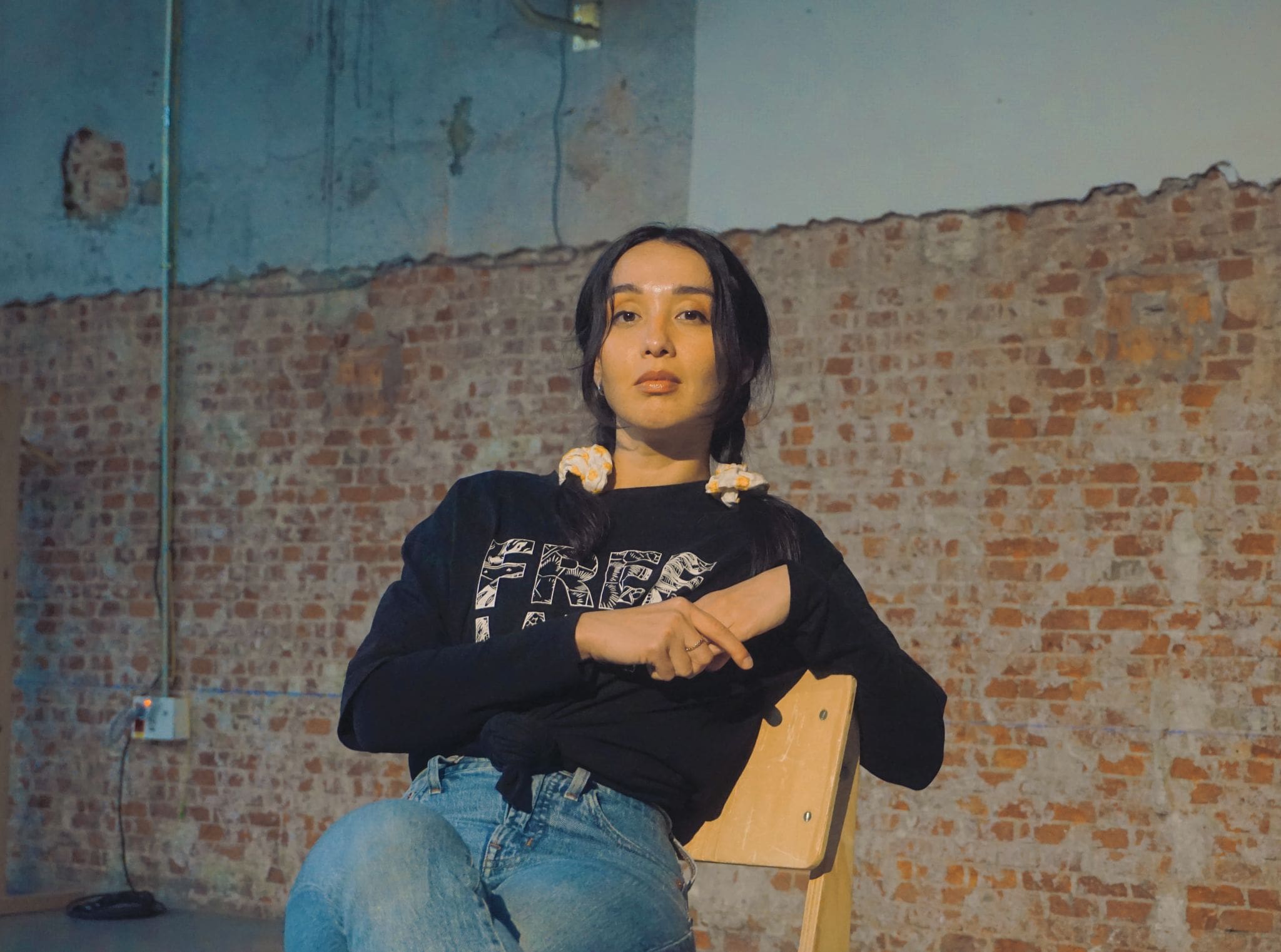
In Tiyan Baker’s exciting practice, you never know what to expect. An artist dedicated to experimenting with new mediums, over her career Tiyan has boldly allowed herself to evolve. However, while her practice is expansive, there has always been cohesiveness in her video installations, sculptures, and photography. Her works are instantly recognisable, achieved through the conceptualisation of artworks that invite us to consider complex themes in a playful yet sophisticated way. She provides accessible pathways to resonate with layered ideas that centre her Bidayǔh culture, bringing awareness to the (re)colonisation of Borneo—an island in Southeast Asia’s Malay Archipelago.
This is true of her most recent work Personal Computer: ramin ntaangan, 2022-2023, a custom PC built in the style of a Bidayǔh longhouse, a gesture to both technological and Indigenous structures of knowledge and exchange that provide connections to her culture.

Recent achievements include winning the National Photography Prize 2022 at Murray Art Museum Albury and participating in Primavera 2023 at the Museum of Contemporary Art—an exhibition centering five esteemed artists under 35 years of age. In 2024 Tiyan will present a commissioned work in collaboration with Jason Phu at Goolugatup in Western Australia, a custom world they will build within the popular video game, Fortnite.
Nicholas Mangan
By Andrew Stephens
Unearthing is literal and metaphoric for Nicholas Mangan, who is looking ahead to a career-defining survey show.

Among the many elements of Nicholas Mangan’s work that intrigue audiences is the way ‘excavation’ is used as a process for unpacking, questioning and examining the connections between culture and nature, but also how ‘digging up’ becomes a visual effect. In his work, there’s always a sense of it having somehow been unearthed.
Operating mainly with sculpture and moving image, Mangan is certainly a type of archaeologist—but one who speculates about rather than defines his findings. While each work is distinct, there is also a continuation of focus. This artist gravitates towards sites, objects and ideas that can be contested, especially through multiple histories or narratives attached to them—as he has noted, this subject matter has included “a disputed tropical mine, a bankrupted island nation, a geological sample of the earliest Earth crust, discarded tourist souvenirs and the remnants of a demolished architectural icon”.
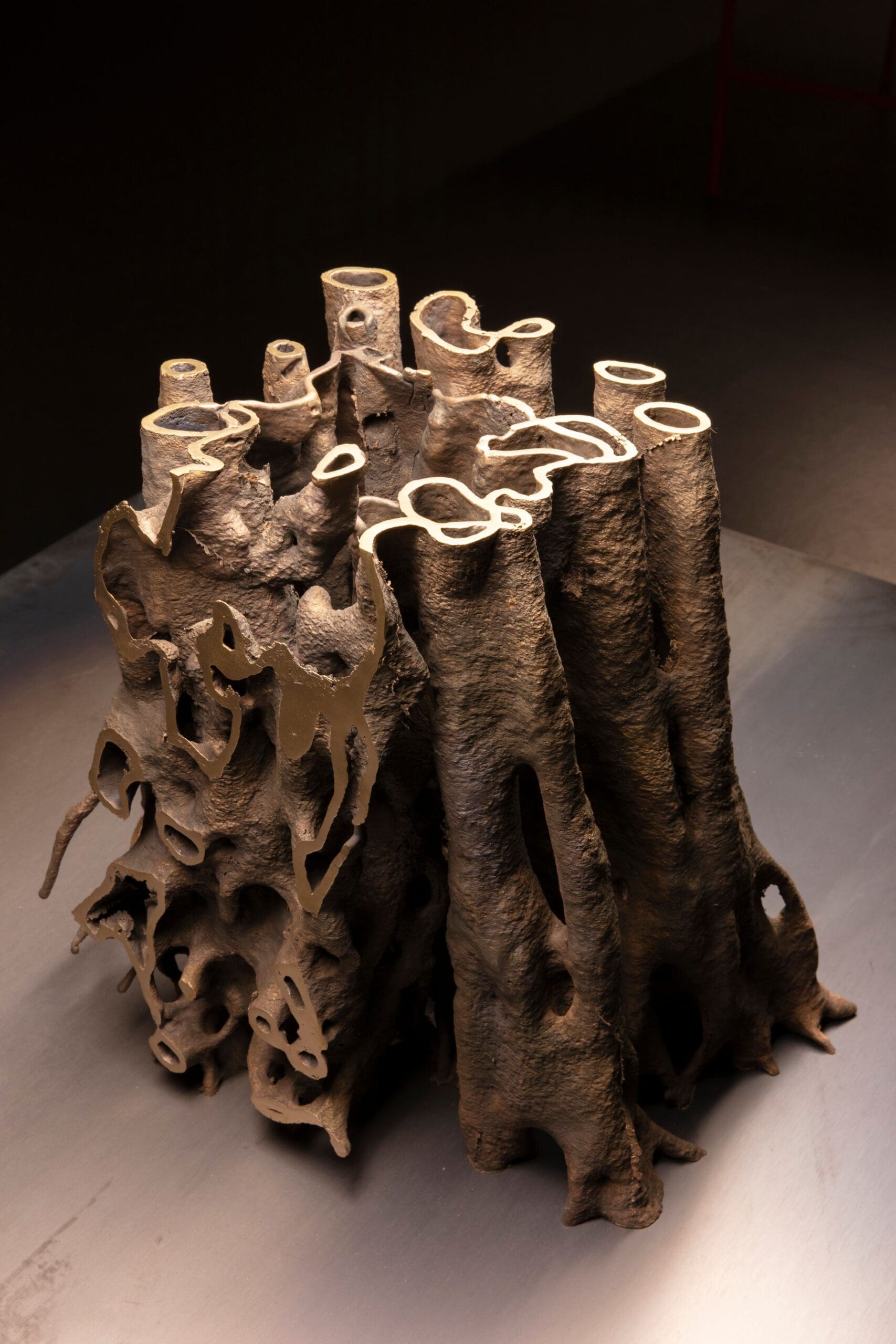
His work includes Core-Coralations, 2021-ongoing, ruminating on the Great Barrier Reef, and Limits to Growth, 2016-ongoing, in which cryptocurrency is investigated. That breadth alone, and the layers of meaning , are part of his great appeal. Later this year, viewers will see how all this has been traced in a major survey at Sydney’s Museum of Contemporary Art.
Nicholas Mangan is represented by Sutton Gallery.
Katie West
By Diego Ramirez
Through textiles and social experiences, Katie West forges exquisite spaces of meditation and decolonisation.

Katie West is a Yindjibarndi woman working significantly, as if her hand was stained with poetry, among textiles, installation and social practice. In the last two years she’s been curated into many of this country’s most prestigious surveys, including The National 4and Ramsay Art Prize in 2023, and Primavera in 2022. Such recognition has afforded great momentum, taking her practice to the United States, where she is part of a travelling exhibition, soon showing at The Block Museum of Art in Chicago.
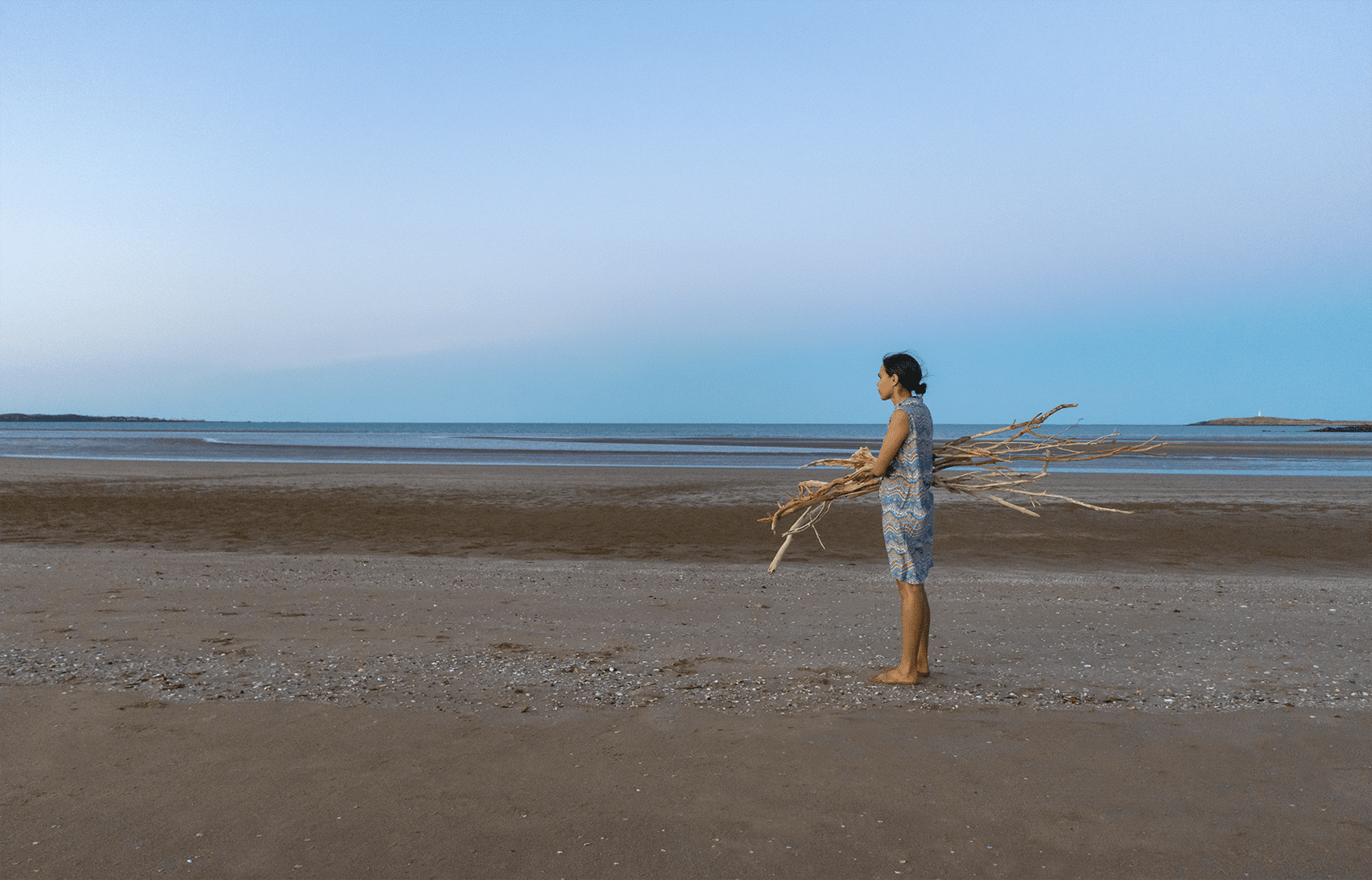
Indeed, Actions for the Earth: Art, Care & Ecology, curated by Sharmila Wood and produced by Independent Curators International, New York, is an exhibition about restorative interventions. Originally shown at the 2022 TarraWarra Biennale, West is participating with her work Clearing, 2019, an installation creating a social space with textiles for listening, thinking, conversing and reading. Clearing offers tactile cushions on the ground, underneath a large-scale drape hanging from the ceiling, offering a space of reflection. Nearby are books on First Nations knowledge, firmly inviting the viewer to clear their preconceptions and consider their positionality in this environment. For 2024, West is also participating in the Indian Ocean Craft Triennial: IOTA24 within an exhibition centering string crafts in Papua New Guinea and Aboriginal communities.
Katie West is represented by Dominik Mersch.




